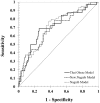Predictive performance of a multivariable difficult intubation model for obese patients
- PMID: 30161197
- PMCID: PMC6117055
- DOI: 10.1371/journal.pone.0203142
Predictive performance of a multivariable difficult intubation model for obese patients
Abstract
Background: A predictive model of scores of difficult intubation (DI) may help physicians screen for airway difficulty to reduce morbidity and mortality in obese patients. The present study aimed to set up and evaluate the predictive performance of a newly developed, practical, multivariate DI model for obese patients.
Methods: A prospective multi-center study was undertaken on adults with a body mass index (BMI) of 30 kg/m2 or more who were undergoing conventional endotracheal intubation. The BMI and 10 preoperative airway tests (namely, malformation of the teeth in the upper jaw, the modified Mallampati test [MMT], the upper lip bite test, neck mobility testing, the neck circumference [NC], the length of the neck, the interincisor gap, the hyomental distance, the thyromental distance [TM] and the sternomental distance) were examined. A DI was defined as one with an intubation difficulty scale (IDS) score ≥ 5.
Results: The 1,015 patients recruited for the study had a mean BMI of 34.2 (standard deviation: 4.3 kg/m2). The proportions for easy intubation, slight DI and DI were 81%, 15.8% and 3.2%, respectively. Drawing on the results of a multivariate analysis, clinically meaningful variables related to obesity (namely, BMI, MMT, and the ratio of NC to TM) were used to build a predictive model for DI. Nevertheless, the best model only had a fair predictive performance. The area under the receiver operating characteristic curve (AUC) was 0.71 (95% confidence interval 0.68-0.84).
Conclusions: The predictive performance of the selected model showed limited benefit for preoperative screening to predict DI among obese patients.
Conflict of interest statement
The authors have declared that no competing interests exist.
Figures



Similar articles
-
The performance of neck circumference and other airway assessment tests for the prediction of difficult intubation in obese parturients undergoing cesarean delivery.Int J Obstet Anesth. 2017 May;31:45-50. doi: 10.1016/j.ijoa.2017.01.011. Epub 2017 Feb 5. Int J Obstet Anesth. 2017. PMID: 28258945
-
Determining the Efficiency of Different Preoperative Difficult Intubation Tests on Patients Undergoing Caesarean Section.Balkan Med J. 2017 Sep 29;34(5):436-443. doi: 10.4274/balkanmedj.2016.0877. Epub 2017 Apr 13. Balkan Med J. 2017. PMID: 28443579 Free PMC article.
-
Comparison of airway assessment tests for prediction of difficult intubation in obese patients: importance of thyromental height and upper lip bite test.Minerva Anestesiol. 2022 Mar;88(3):114-120. doi: 10.23736/S0375-9393.21.15764-5. Epub 2021 Oct 28. Minerva Anestesiol. 2022. PMID: 34709011
-
Predictive parameters of difficult intubation in thyroid surgery: a meta-analysis.Minerva Anestesiol. 2020 Mar;86(3):317-326. doi: 10.23736/S0375-9393.19.14127-2. Epub 2020 Jan 8. Minerva Anestesiol. 2020. PMID: 31922378
-
Obesity and the Other Independent Predictors in Elective Endotracheal Tube Intubations: A Narrative Review.J Clin Med Res. 2022 May;14(5):177-187. doi: 10.14740/jocmr4727. Epub 2022 May 31. J Clin Med Res. 2022. PMID: 35720231 Free PMC article. Review.
Cited by
-
Morphological specificity analysis of an image-based 3D model of airway filling in a difficult airway.BMC Anesthesiol. 2022 Nov 3;22(1):336. doi: 10.1186/s12871-022-01880-6. BMC Anesthesiol. 2022. PMID: 36329383 Free PMC article.
-
Clinical predictors for perioperative anticipated and unanticipated difficult intubation: a matched case-control study.Sci Rep. 2025 Mar 17;15(1):9078. doi: 10.1038/s41598-025-93609-x. Sci Rep. 2025. PMID: 40097554 Free PMC article.
-
Clinical versus Ultrasound Measurements of Hyomental Distance Ratio for the Prediction of Difficult Airway in Patients with and without Morbid Obesity.Diagnostics (Basel). 2020 Mar 3;10(3):140. doi: 10.3390/diagnostics10030140. Diagnostics (Basel). 2020. PMID: 32138351 Free PMC article.
-
Styletubation in Bariatric Surgery: A Case Report.Healthcare (Basel). 2023 Aug 10;11(16):2256. doi: 10.3390/healthcare11162256. Healthcare (Basel). 2023. PMID: 37628454 Free PMC article.
-
Evaluation of preoperative difficult airway prediction methods for adult patients without obvious airway abnormalities: a systematic review and meta-analysis.BMC Anesthesiol. 2024 Jul 17;24(1):242. doi: 10.1186/s12871-024-02627-1. BMC Anesthesiol. 2024. PMID: 39020308 Free PMC article.
References
-
- Jacobsen J, Jensen E, Waldau T, Poulsen TD. Preoperative evaluation of intubation conditions in patients scheduled for elective surgery. Acta Anaesthesiol Scand. 1996;40(4):421–4. - PubMed
-
- Punjasawadwong Y, Sriraj W, Charuluxananan S, Akavipat P, Ittichaikulthol W, Lapisatepun W, et al. Perioperative and anesthetic adverse events in Thailand (PAAd Thai) incident reporting study: Hospital characteristics and methods. Asian biomedicine: Asian biomedicine; 2017. 33–9 p.
-
- Hawkins JL. Providing anesthesia for the morbidly obese patient. Seminars in Anesthesia, Perioperative Medicine and Pain. 1995;14(3):204–9.
Publication types
MeSH terms
LinkOut - more resources
Full Text Sources
Other Literature Sources
Medical
Miscellaneous

